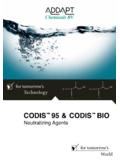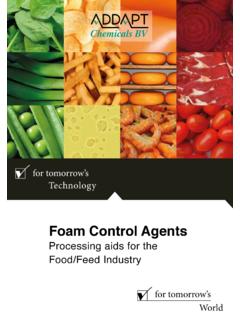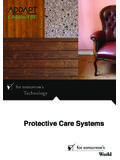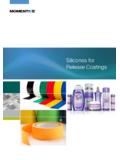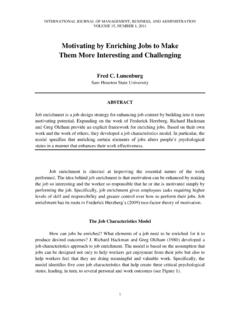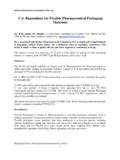Transcription of Tackifiers - ADDAPT Chemicals BV - Environmentally ...
1 Tackifiersfor Lubricants and Greasesfor tomorrow sWo r l dfor tomorrow sTechnologyChemicals BVIntroduction Industrial and automotive fluids, on many occasions, require an additive that improves the adhesion and/or tackiness of the fluid to the surface, which is lubricated with a lubricant or , natural rubber and latex dissolved in mineral oil or esters, are known to be excellent additives which provide such kind of properties. The production of these additives require high skill and care in order to avoid the breakdown of the chemical structure of these Chemicals ; large molecular weight molecules are normally shear sensitive and special precautions have to be taken to optimise application has its own need for a tackifier .
2 For this reason ADDAPT Chemicals BV developed a range of Tackifiers . Correct choice of tackifier ensures optimised usage with the optimum of performance at the lowest treat is important to mention that an anti-mist additive (required in the cutting and grinding industry) normally does not have the tackifying properties that standard Tackifiers exhibit. This finds its origin in the structure of the solid dissolved in the mineral oil. Anti-mist additives contain relatively low molecular weight solids. High molecular weight solids will block the filters of the circulating oil. 2 Product range for the lubricant industry We introduce the following range of Tackifiers to the lubricant industry:ApplicationsTackifiers find their application in many different areas.
3 Some examples are shown below: Automotive chassis greases Industrial extreme pressure greases Automotive undercoating Bar and chain saw oil Pneumatic drill oil Aluminium forming fluids Slide way lubricants Oil based rust preventatives Water based preventatives Air compressor and cylinder lubricants Gear oils Spindle oils Machine oils Cutting oils (anti-mist grade) Textile machinery oilIt is important to know the final application in order to choose the correct grade. Spindle oils normally require a tackifier of very light colour and a very high tackifying property as well as low viscosity (Tac M 7).
4 This is in contrast to applications where there is no colour specification required and high viscosity is desired. Standard Tackifiers should not be used where only anti-mist properties are is not the determining feature for tackifying properties. This is shown later on in this brochure where test results of Tac M 7 (low viscous) are compared with tests result obtained from Tac M 55 (high viscous). Tackifying properties can be determined in different ways; we recommend the usage of the test procedure as shown on page 6. Tac M 7 Light colour, high performing PiB in mineral oilTac M 8 Light colour, high solid containing Tackifiers , medium viscosityTac M 9 Colourless, low viscous, high performing PiBTac M 55 Concentrated PiB solution in mineral oilTac E 60 Natural rubber dissolved in vegetable oil3 Products Tac M 55 Tac M 55 is the most general tackifier used in the lubricant industry.
5 It has a similar performance, viscosity and colour as well known grades such as Paratac and Adichem C. Because of the colour (dark brown), this product is not suitable for spindle oil or other fluids which come in contact with textiles and are sensitive to dark coloured tackifying performance is shown in the paragraph Test methods and shows comparable performance of Tac M 55 with the performance of Adichem M 7 Tac M 7 is a medium viscous tackifier with very light colour. In spite of the low viscosity, the content of solids is similar to the standard grades. The low viscosity makes Tac M 7 an easy to handle tackifier ; which does not have to be stored at higher temperatures, it can be handled without difficulties at room temperatures.
6 This grade can be used in the spindle oil industry. Although the medium viscosity gives the impression that the tackifying properties are worse than the tackifying properties of a high viscous grade, the test result gives a strong indication that the tackifying properties of Tac M 7 are superior to the tackifying properties of all other commercial tackifier grades (see page 5 Test methods ). Application areas: all application areas as mentioned above (industrial fluids, cutting fluids).Tac M 8 Tac M 8 is similar to Tac M 7, it shows the same colour as Tac M 7. The solid content is higher than the solid content for Tac M 7 and the viscosity is rated as medium.
7 The tackifying properties are rated as very good in the tackifying test mentioned at the end of this M 9 Tac M 9 is a low viscous tackifier which is colourless and transparent. In spite of the low viscosity, the content of solids is similar to the standard grades. The low viscosity makes Tac M 9 a very easy to handle tackifier ; it does not have to be stored at higher temperatures, it can be handled without difficulties at room temperatures. This grade has been developed mainly for the spindle oil industry. The tackifying properties of Tac M 9 are superior to the tackifying properties of all other commercial tackifier grades (see page 5 Test methods ).
8 Application areas: all application areas as mentioned above (industrial fluids, cutting fluids) including spindle E 60 Tac M 7 and Tac M 55 are based on mineral oil as solvent - carrier for the PiB. In several cases, the end-user prefers the fully formulated lubricant to be based on biodegradable ingredients. In this case the tackifier should also be based on biodegradable Chemicals . Tac E 60 is a light coloured tackifier based on vegetable oils as solvent-carrier. The tackifier exhibits excellent tackifying properties, with tackifying properties between Tac M 55 and Tac M test results obtained with Tac E 60 showed again that the viscosity of the tackifier is not the determining parameter of the tackifying properties of the resulting lubricant (Tac M 55 and Tac E 60 have similar viscosities at room temperature and at higher temperatures).
9 Application areas: chain saw oils, hydraulic fluids, greases and ester based cutting methods In practice the so-called threadiness (ductility) is regarded as the most important criterion for the effectiveness of a tack improver. Several existing test methods measure threadiness; none is covered by any accepted standard. The ADDAPT Chemicals BV in house method determines the amount of oil left on the surface of the Brookfield spindle after submerging the spindle in the tackifier containing mineral oil. The spindle rotates for 10 minutes at a high rpm before measuring the weight of the spindle. Depending upon concentration, base oil properties and temperature, the effectiveness of a tack improver can be viscosity of tack improvers should ensure easy incorporation.
10 This way the shear stress, necessary in manufacturing, can be kept to a minimum, which is useful for the tack improvers. Tackifiers are generally sensitive to descriptionIn the next paragraph the details of the test method show how to reproduce the test data very brief it is a mineral oil solution which contains , and pbw of the tackifier . The technician should use the largest Brookfield spindle and after the spindle has been taken from the solution, the spindle is rotated for a fixed number of rpm at a fixed time. In case the tackifying properties are poor, the mineral oil will spin off from the spindle.


